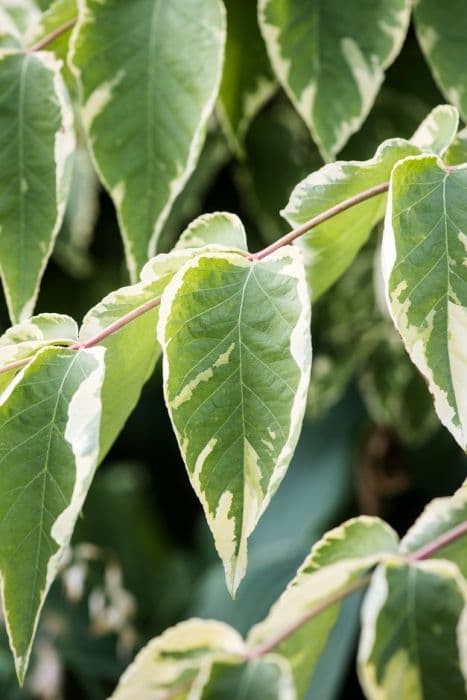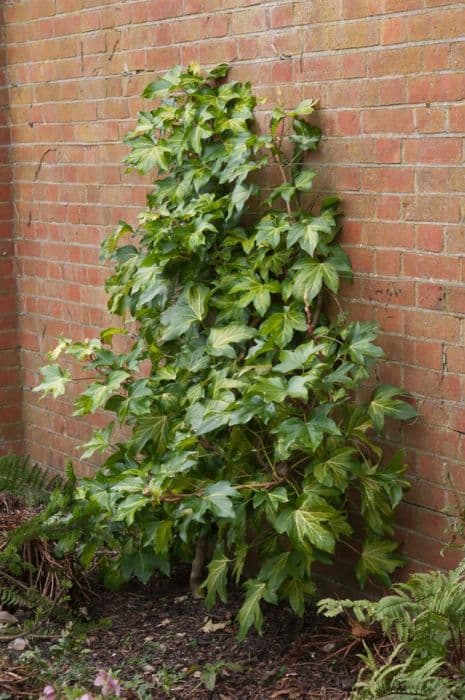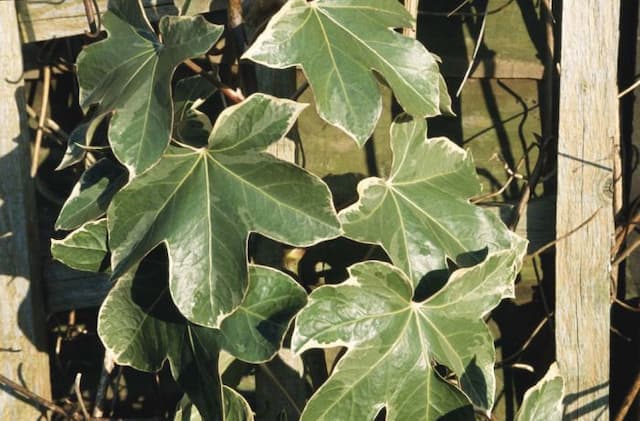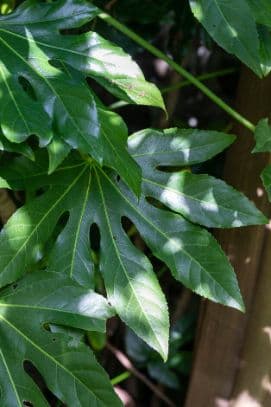English Ivy Hedera helix 'Little Diamond' (v)

ABOUT
The English ivy 'Little Diamond' is a variant of the classic ivy known for its ornamental qualities. It has a dense growth habit with leaves that are smaller and more intricate than those of the standard English ivy. The foliage is a rich, deep green color with prominent, creamy-white or silver markings that form a distinctive diamond-like pattern at the center of each leaf. The leaves are glossy and have a leathery texture, shaped with three to five pointed lobes that give them a star-like appearance. The vine itself is trailing or climbing, equipped with aerial roots that allow it to adhere to surfaces and supports such as walls or trellises. The appearance of English ivy 'Little Diamond' is often admired for its ability to provide a lush, green carpet of leaves when allowed to spread horizontally on the ground, or as an elegant green drapery when trained vertically. The contrast between the deep green leaves and their lighter variegation makes this plant especially attractive for adding visual interest to both indoor and outdoor environments.
About this plant
 Names
NamesFamily
Araliaceae.
Synonyms
English Ivy, Common Ivy, European Ivy.
Common names
Hedera helix 'Little Diamond'
 Toxicity
ToxicityTo humans
English ivy is considered to be mildly to moderately toxic if ingested by humans. It contains triterpenoid saponins which, when eaten, can cause gastrointestinal symptoms such as nausea, vomiting, diarrhea, and abdominal pain. It may also result in a burning sensation in the mouth and throat. In some cases, dermal contact with the plant can lead to skin irritation or allergic reactions.
To pets
English ivy is also toxic to pets, including cats and dogs. The plant contains compounds such as falcarinol and polyacetylene that can cause vomiting, abdominal pain, hypersalivation, and diarrhea if ingested. In severe cases, ingestion can lead to more serious symptoms such as difficulty in breathing, weakness, and ataxia, which is a lack of muscle coordination. Contact with the plant can also cause dermatitis in pets. If pets consume English ivy, it is important to contact a veterinarian promptly.
 Characteristics
CharacteristicsLife cycle
Perennials
Foliage type
Evergreen
Color of leaves
Variegated
Height
6-9 inches (15-23 cm)
Spread
1-2 feet (30-60 cm)
Plant type
Climber
Hardiness zones
5-9
Native area
Europe
Benefits
 General Benefits
General Benefits- Low Maintenance: The English Ivy 'Little Diamond' variant is relatively easy to care for, requiring minimal upkeep once established.
- Versatility: Can be used in a variety of landscape settings, including ground cover, climbing walls, or in containers.
- Aesthetic Appeal: Its variegated leaves add visual interest to gardens, with a pattern that can brighten shady spots.
- Hardiness: It is a hardy plant that can withstand a range of climatic conditions and is resilient to many pests and diseases.
- Erosion Control: Effective at preventing soil erosion due to its dense growth habit when used as ground cover.
- Wildlife Support: Provides shelter and sometimes food for birds and insects within its dense foliage.
- Seasonal Interest: Evergreen nature ensures year-round greenery, with additional seasonal changes in foliage colour.
- Adaptability: Capable of adapting to various soil types, though it prefers well-drained, moist soils.
- Urban Tolerance: Tolerates urban pollution and conditions, making it suitable for city gardens and public landscaping.
 Medical Properties
Medical Properties- This plant is not used for medical purposes.
 Air-purifying Qualities
Air-purifying QualitiesThis plant is not specifically known for air purifying qualities.
 Other Uses
Other Uses- Hedera helix 'Little Diamond', commonly known as English ivy, can be used in topiary art to create lively green sculptures in gardens or indoor spaces due to its ability to climb and conform to structures.
- English ivy can be trained to grow over unsightly fences, offering a natural and aesthetic covering that can transform a chain-link fence into a lush green wall.
- This plant's dense foliage can be used as a living mulch to cover the ground under taller plants, which can help retain soil moisture and suppress weeds.
- When grown in hanging baskets, English ivy can provide vertical green accents, cascading down with its elegant foliage, adding depth and interest to interior design.
- English ivy can be used to create a natural backdrop for photographing other plants or garden features, its dense leaves offering a uniform and distraction-free background.
- This variety of ivy can be crafted into wreaths or garlands during the holiday season, providing a traditional and timeless decor element.
- English ivy can be utilized as a natural screen around patios or outdoor sitting areas, providing privacy as well as a pleasant ambiance.
- When planted in containers on a balcony or terrace, English ivy can create a green curtain that can help reduce noise pollution and provide an urban oasis.
- Used as a ground cover in theme parks or zoos, English ivy can contribute to the creation of themed landscapes mimicking the lush undergrowth of various natural habitats.
- English ivy can be used in floral arrangements as a filler plant, its trailing vines and distinctive leaves adding volume and texture to bouquets or centerpieces.
Interesting Facts
 Feng Shui
Feng ShuiThe English Ivy is not used in Feng Shui practice.
 Zodiac Sign Compitability
Zodiac Sign CompitabilityThe English Ivy is not used in astrology practice.
 Plant Symbolism
Plant Symbolism- Connection and Friendship: This variety of English ivy often symbolizes strong bonds and relationships due to its nature of clinging and intertwining with structures and other plants, representing the interconnectedness of friendships and community.
- Eternal Life: The evergreen quality of English ivy, which stays green throughout the year, is seen as a symbol of immortality and eternal life, making it a common motif in various cultures.
- Fidelity: English ivy is traditionally used in wedding decorations because its ability to adhere firmly to surfaces is seen as a metaphor for fidelity and steadfastness in marriage.
- Protection: In some folklore, it is believed that ivy wards off evil spirits. Thus, planting English ivy near the home was thought to offer protection to the inhabitants.
- Survival and Resilience: Its hardy nature and ability to thrive in challenging conditions symbolize the human capacity for survival and resilience against adversity.
 Water
WaterEnglish Ivy should be watered regularly, ensuring that the soil stays evenly moist but not waterlogged. It's best to use the touch test; when the top inch of the soil feels dry, it's time to water again. Typically, this might mean watering once every 7 to 10 days, but this can vary with environmental conditions such as temperature and humidity. When watering, provide enough water so that it runs through the drainage holes—approximately 16 to 32 ounces, depending on pot size, should be sufficient. Adjust watering frequency during the winter months, watering less often as the plant's growth slows.
 Light
LightEnglish Ivy thrives in bright, indirect light but can also adapt to low-light conditions. The best spot for the plant would be near a north or east-facing window where it can receive gentle morning sunlight without the harsher afternoon rays. Avoid placing English Ivy in direct sunlight as this can scorch the leaves.
 Temperature
TemperatureEnglish Ivy prefers a cool to moderate temperature range, ideally between 50 to 70 degrees Fahrenheit. The plant can tolerate temperatures down to about 50 degrees but will be damaged by temperatures below freezing. It’s also not well-suited to high heat, particularly temperatures consistently above 80 degrees Fahrenheit.
 Pruning
PruningEnglish Ivy benefits from regular pruning to promote bushy growth and to keep it manageably sized. Prune as needed to remove any dead or damaged leaves and to shape the plant, ideally in the spring before the new growth starts. Trimming once or twice a year is generally sufficient, but feel free to prune sporadically to maintain the desired form.
 Cleaning
CleaningAs needed
 Soil
SoilEnglish Ivy 'Little Diamond' thrives in a well-draining soil mix comprising equal parts peat, perlite, and potting soil. A pH level of 6.0 to 7.5 is ideal for this plant to maintain healthy growth.
 Repotting
RepottingEnglish Ivy 'Little Diamond' should be repotted every two to three years, or when it becomes root-bound to encourage continued growth.
 Humidity & Misting
Humidity & MistingEnglish Ivy 'Little Diamond' prefers a humidity level of about 40-50%, which mimics its natural environment and supports vibrant foliage.
 Suitable locations
Suitable locationsIndoor
Place English Ivy 'Little Diamond' in bright, indirect light and ensure high humidity.
Outdoor
Grow English Ivy 'Little Diamond' in partial shade, shelter from harsh sun.
Hardiness zone
5-11 USDA
 Life cycle
Life cycleHedera helix 'Little Diamond', commonly known as English Ivy, begins its life cycle as a seed, which, once germinated, grows into a small seedling with typical ivy-shaped leaves. As it matures, it develops into a juvenile vegetative phase, characterized by rapid growth and adherence to surfaces with aerial rootlets. During this stage, the leaves are often more lobed and the plant does not flower. Upon reaching maturity, which may take several years, it enters the adult vegetative stage where the leaves become more diamond-shaped and less lobed. At this stage, the plant may develop umbels of small, greenish-yellow flowers, which, if pollinated, will produce blue-black berries as fruit. These fruits are later consumed by birds and other animals, leading to seed dispersal and the beginning of a new plant's life cycle.
 Propogation
PropogationPropogation time
Spring-Early Summer
English Ivy 'Little Diamond', a variegated cultivar of Hedera helix, is most commonly propagated through stem cuttings. The best time to take cuttings for propagation is late spring through early summer, when the plant is actively growing. To propagate, cut a 4 to 6 inch (10 to 15 cm) section of stem, making sure it includes at least one set of leaves. Remove the leaves from the lower half of the cutting, and submerge that portion in water or dip it in rooting hormone powder before planting it in a pot filled with a mix of peat and perlite or sand. Keep the soil moist and place the cutting in indirect light at a temperature around 70 to 75 degrees Fahrenheit (21 to 24 degrees Celsius). Roots should develop within a few weeks, after which the new English Ivy can be transplanted to its permanent location.









